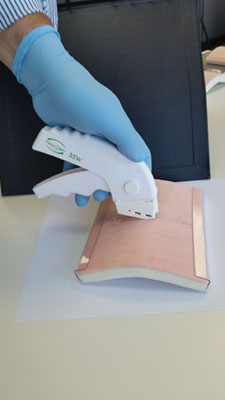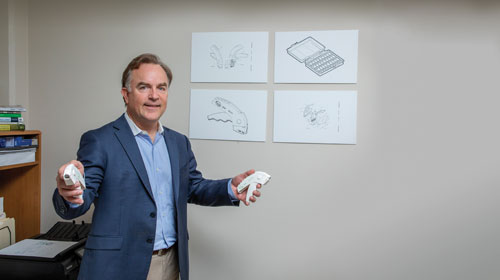 Sugarcane plants and operating rooms have nothing in common, and yet when Rob Chase, president and founder of NewGen Surgical in San Rafael, struck on an idea to bring them together, it was a logical pairing that had the potential to deliver benefits for generations to come. His concept was to create surgical equipment out of the plant’s fiber, which would allow hospitals to reduce their carbon footprint by using products that are healthier for the planet than those made of plastic.
Sugarcane plants and operating rooms have nothing in common, and yet when Rob Chase, president and founder of NewGen Surgical in San Rafael, struck on an idea to bring them together, it was a logical pairing that had the potential to deliver benefits for generations to come. His concept was to create surgical equipment out of the plant’s fiber, which would allow hospitals to reduce their carbon footprint by using products that are healthier for the planet than those made of plastic.
The inspiration came from his 20-plus year experience working in operating-room sales, sales management, clinical education and marketing within the medical device industry and earning a sustainable practices certificate from Dominican University’s Barowsky School of Business, where he enrolled in 2010 after becoming interested in the university’s Green MBA program. “The idea came about from going back to school,” says Chase. “During that coursework, I became enlightened about pollution, particularly plastic pollution,” he explains. As he became increasingly aware of how unsustainable health care practices were, particularly in the operation room (OR) where 30 percent of all hospital waste is generated, he developed an interest in applications for surgical use.
“Much of the industry is built around single-use disposable products,” he explains, and most are made of plastic because it provides consistency of performance, guaranteed sterility and convenience—much as it does in our daily lives. Plastic, however, is petroleum-based, thus using finite resources, and it is difficult to recycle and doesn’t biodegrade for hundreds of years. As a result, it’s either incinerated or languishes in the environment for centuries, making it increasingly undesirable. “Health care is built on plastics, and I saw an opportunity to find out how to solve the problem,” says Chase. The challenge was finding ways to bring plant-based products and surgery together effectively in the unique environment of an operating room, where changes are rare. “Everything is rooted in understanding the OR and how it works, along with product and procedural knowledge.” When designing new surgical products, he adds, it’s essential to make sure there’s no change in product performance and that the products can be integrated into existing work flows.
Step by step
 Chase launched NewGen Surgical in 2012 with an idea that was visionary, but had no guarantee of success. “It was a bit scary to go down that road, at this point in my career, with all the uncertainty,” he recalls. He started small, and in the beginning, the company consisted of Chase and just one engineer, Paul Kardel of Kardel Design Group, who spent a couple of years on product development through trial and error. The first product was a skin stapler, and Chase’s initial knowledge came from his own operating-room experience as the representative of a manufacturer of medical devices with a focus on surgical stapling. One of his first steps was talking to other successful entrepreneurs and surgeons about the product he imagined, so he could validate the idea. Part of this validation process included developing an in-depth knowledge of how the product had to perform, with details such as how it’s used as well as interaction with other surgical staff. Kardel then started work to design a stapler based on Chase’s idea, along with guidance from contacts in the industry and his own experience in developing products until they became viable. “It started with one engineer to design one product,” says Chase. Meanwhile, he did sales and marketing research and ran another company that distributed items for cardiac and thoracic surgery.
Chase launched NewGen Surgical in 2012 with an idea that was visionary, but had no guarantee of success. “It was a bit scary to go down that road, at this point in my career, with all the uncertainty,” he recalls. He started small, and in the beginning, the company consisted of Chase and just one engineer, Paul Kardel of Kardel Design Group, who spent a couple of years on product development through trial and error. The first product was a skin stapler, and Chase’s initial knowledge came from his own operating-room experience as the representative of a manufacturer of medical devices with a focus on surgical stapling. One of his first steps was talking to other successful entrepreneurs and surgeons about the product he imagined, so he could validate the idea. Part of this validation process included developing an in-depth knowledge of how the product had to perform, with details such as how it’s used as well as interaction with other surgical staff. Kardel then started work to design a stapler based on Chase’s idea, along with guidance from contacts in the industry and his own experience in developing products until they became viable. “It started with one engineer to design one product,” says Chase. Meanwhile, he did sales and marketing research and ran another company that distributed items for cardiac and thoracic surgery.
Next came testing the prototype with a clinical advisory group comprised of doctors, nurses and surgical technicians, who could validate that the product’s design and performance was in line with surgical staff expectations and that they would accept and use this new product. Kardel subsequently set out to refine the prototype made out of a plant-based material that would be less harmful than plastic, and he and Chase finalized the design, using Bagasse, a leftover fiber from sugarcane.
By 2014, the company had made progress, but Chase and Kardel experienced significant challenges, and Chase began to question whether success was possible. “I wasn’t sure if we were ever going to get to that point,” he says, and he points to technical challenges in the engineering of a new device and raising money to go to the next level as particularly difficult. “It’s overcoming the fear of failure,” he explains. In addition, he didn’t want to put other people’s money at risk until he knew the venture was going to be successful, and so he was personally financing the endeavor, which meant putting his family and personal assets on the line. “I was lucky to have the invaluable marketing expertise of my wife, Kimberlee, as well as her determination to make this idea work for health care,” he says. He also knew what he wanted to pursue, and so he persevered, and the company moved forward.
In June 2014, it introduced its new skin stapler at CleanMed 2014, a national conference for leaders in heath-care sustainability at the Global Center for Health Innovation in Cleveland, Ohio. During this time of heavy emphasis on research and development, NewGen Surgical won awards and commendations for its innovation and market-disrupting ideas from diverse organizations such as the World Economic Forum and North Bay iHub. NewGen Surgical was on its way, and it eventually became all-consuming to the point that Chase sold his other company. “NewGen Surgical is where my passion lies,” he says. “We were an R & D organization and in production development for a long time,” he observes, but that is the nature of the business.
The timeline for product development is a demanding and time-consuming process that takes from six months to three years, depending on the complexity of the item, and working with an attorney to obtain a patent takes additional time. So far, NewGen Surgical has received patents for five products and has multiple patents pending. “At a critical time—our first product proven and in manufacturing, awards for innovation received and patents in hand for new product lines—we had to grow the business as a medical device manufacturer and add full-time employees to key departments,” Chase adds. “Thankfully, at that critical juncture, we got the additional investment we needed from friends and family, and took off from there. NewGen Surgical grew the company by adding a team of talented and experienced people dedicated to the mission, an expert panel of advisors comprised of physicians, health-care workers, business and sustainability leaders, a principal engineer, materials engineers, and departments focused on strategic marketing and product development.

For the next few years, the company continued product development, maintaining focus on quality and product releases. Then with the support of a forward-thinking Fortune 500 health-care company, NewGen Surgical was able was able to transition to large-scale production and increase key areas of business; product development continued with an added emphasis on large-scale production, sales and branding. NewGen acquires the sugarcane fiber, which is used for parts such as the skin stapler’s handle and lever, in Thailand and has the devices manufactured in China and Taiwan. Production was in the United States at first, but then Chase discovered that his competitors were having their products made overseas, and his domestic costs were four times what others were paying elsewhere. “Most of the products we’re producing are low-cost commodity items,” says Chase. “I would like to do it here and create jobs here, but economically it doesn’t make sense. We can create jobs in marketing, sales and engineering, but manufacturing will still have to be done overseas.”
Aligning goals
NewGen Surgical products are now in use in 44 hospitals, and it has shipped more than 130,000 units to its customers. Its principal marketing is to health-care systems, and the ongoing challenge is to get them to switch to more environmentally responsible products, when what they are already using works well. Making change goes beyond the product itself and requires the conscious recognition of a healthy environment.
Chase reports that something to the tune of 13,000 tons of waste comes out of hospitals in the United States every day, and that although people are often slow to make a connection between the counter-productive waste hospitals generate and a mission to heal, they’re becoming more mindful of the relationship between the environment and human health. The result is a growing understanding of the need to reduce the environmental footprint and greenhouse gas emissions of hospitals. Thus, among NewGen’s goals is a desire to make use of what it has learned, leveraging the existing supply chain it has established to design more single-use disposable products that can help hospitals become what Chase calls “climate-smart consumers.”
The company’s Smart Sustainable DesignTM has performance, sustainability and economics as its drivers, and it supports United Nations Sustainable Development Goal 12, which calls for responsible consumption and production and is one in a set of global goals for 2030. In addition, NewGen Surgical offers its Small Change, Big Impact EPP program to hospitals to support their transition to more sustainable products. “It’s a program that hospitals can participate in, and we will feed them back the metrics of how much plastic waste they’ve avoided,” says Chase, explaining that the company has calculated the metrics of each product. The information allows hospitals to share their progress on reducing plastic waste and greenhouse gas emissions with their stakeholders and employees. “We’re trying to get to the same place together, which is a more sustainable health-care system,” he says.
Reaching out
Many hospitals are part of integrated delivery networks, which are coordinated organizations with a formal system of providers and care sites, and NewGen Surgical markets to them directly at the system level. Chase observes that any new product has early adopters and laggards, and those at the forefront of the change to sustainable practices in the health-care field understand the connection between human health and the environment. They are inspiring leaders with power and passion. “These leaders get it, and understand that what they purchase has impact—impact on their own environment goals and they industry,” says Chase. They are seeking ways to positively impact community health, and eliminating plastic in hospitals system-wide is one way to do it. He reports that San Francisco-based Dignity Health, which is comprised of 41 hospitals and 400 care centers in California, Arizona and Nevada, has been a leader in supporting the production and use of sustainable products throughout its entire health-care system, and it is using NewGen’s products in all its hospitals. In fact, with just one product,
Dignity Health has already eliminated more than 3.5 tons of plastic waste in one year.
Sister Mary Ellen Leciejewski, Dignity Health’s vice president of corporate responsibility, is a nationally recognized leader on health-care sustainability and was one of the first recipients of a master’s degree in environmental sciences. She created a set of environmental goals for the system with a target date of 2020, and among them are less waste, safer chemicals, renewable energy and smarter purchasing. “When we look at those goals, some of them overlap,” she points out. Less waste, for example, could be a result of smarter purchasing. “We need to pay attention to the products and processes we are using,” she adds, pointing out that poor choices can affect air quality, which in turn can affect breathing, the heart and the lungs. “We need to keep making the connection between our product choices and our health.”
Dignity Health has been using NewGen Surgical’s products in its operating rooms system-wide for almost two years. Chase approached Leciejewski first with the skin stapler and later with the needle counter, and after working with him for a short time, the purchasing team decided that Dignity Health should adopt the company’s products. “The thing that intrigued us was that it wasn’t made out of plastic. It was made out of the waste of sugarcane,” she recalls. ”Hospitals use so much plastic and single-use plastic. If there are alternatives we could switch to, that would be the way to go.” She says it was easy to begin using a new needle counter, because it’s a management tool and is important for safety. However, for some physicians, she adds, switching to this new stapler was a greater challenge because they have a strong preference for a particular model.
Beyond the opportunity to eliminate petroleum-based products, one or the greatest selling points for Dignity Health was the responsiveness of Chase and his colleagues to any questions the staff had. “NewGen Surgical has visited nearly every one of our 41 hospitals with surgical centers,” says Leciejewski. The visits covered product development, and the NewGen team asked if the products would meet their needs and what could be done to improve them. Their visits included demonstrations so clinicians, including a physician who uses a stapler, could look at them, touch them and ask questions, whether it was about ease of use, patient safety or the components used in a device’s manufacture. “Rob was just right there, working with the team. For Rob and his team to go there and find out what was needed was a game changer,” Leciejewski reports. “Collaboration is strength. We’re working closely with vendors to help turn our vision into reality. The partnership piece is critical as we move forward.”
According to Chase, it’s important to interact with health-care workers if they’re to accept new products because they must be assured that new equipment meets their clinical and performance needs and is easy to use. The transition also needs to be seamless for health-care systems. “We’ve gone in and socialized it ahead of time,” he says. As a result, adopting something new demonstrates alignment with their sustainable goals, and isn’t just a purchasing decision. “We’re going to systems that are looking for these sustainable solutions,” he says. “We’re aligning ourselves with their goals. We’re trying to get to the same place together, which is a more sustainable health-care system.”
He adds that the industry is unique, and the market he is going after is complex, so it’s a slow process. “We have structural barriers to progress,” he says. People tend to do things the way they have in the past, he adds, and they’re inclined to purchase products that are familiar. “We’re not only looking to create sustainable products and innovate, but also break through some of these structural barriers in the hospital supply chain,” he says. “Working with the early adopter hospital systems will help pave the way and bring about change in the acceptance of sustainable products.”
Hope for the future
 Chase would also like to see hospitals move more toward United National Development Goal 12 and sees it as an urgent need. “We have a short timeframe in which we need to change how we do things,” he says. Moving away from petroleum-based products to ones that are more sustainable would be a big step forward that would decrease greenhouse gas emissions and reduce the current dependence on oil.
Chase would also like to see hospitals move more toward United National Development Goal 12 and sees it as an urgent need. “We have a short timeframe in which we need to change how we do things,” he says. Moving away from petroleum-based products to ones that are more sustainable would be a big step forward that would decrease greenhouse gas emissions and reduce the current dependence on oil.
“It comes down to protecting the environment for future generations. We can’t live healthy lives if we have an unhealthy environment,” he says. “It can’t just be all about price. We have to look at the end goal, not just the cost. That’s what drives me.”
He adds that it’s not just about one company that’s innovating. It has to be a real collaboration and partnership with hospitals, manufacturers and he hopes other businesses will follow his lead, rather than focusing just on maintaining the status quo. He explains that one of the benefits of rethinking a commodity to make it sustainable is the opportunity to create new intellectual property. In the case of the skin stapler, new intellectual property came with solving the engineering challenges, which were unique, and discovering how to make a plant-based material function like a hard, rigid plastic product without compromising performance. “I remain hopeful that we’re going to get to this place we envision, a sustainable health-care system that supports a healthy environment,” Chase says. But he points out that it needs to be done faster and on a greater scale. “Otherwise, the next generation is going to wonder what we were doing.”
Chase’s vision for a health-care system that is more sustainable has its champions. He reports that all along the way, he’s had doctors and surgical staff encouraging him to continue on the path he’s chosen, and he’s never had any negative feedback. He also has kudos for members of NewGen Surgical’s staff and their commitment, and the advisory board. “We have a great team here. I’m the founder, but the whole time, I’ve been supported by a highly-professional, motivated, passionate group of employees committed to our success and being a part of making a difference,” he says. “NewGen Surgical is a company of people determined and driven to make a positive impact on the world.”
It hasn’t been an easy path, because innovation comes with sacrifices that involve time, money and relationships. “You have to give up a piece of all of those to be successful,” he says, giving late hours at work as an example, because he has three children and has had to spend time away from them. On the upside, though, he points out that they’ve learned to become more self-sufficient and they support the company’s mission. His eldest son, Jonathan, for example, sometimes works on-site with the engineering and operations side of the business. “Between my children and out interns, the younger generations are truly passionate about making change happen.”
As for the future, Chase and NewGen Surgical continue to make progress a step at a time, pursuing a vision that will make the world better. And he’s committed because it comes down to protecting the environment for future generations. It’s his motivation for chasing a dream and turning it into reality, and that’s what makes it all worthwhile.
United Nations Sustainable Development Goal 12
The United Nations Sustainable Development Goals seek to address issues relating to social, economic and environmental development in areas of concentration that include poverty, hunger, health, education, gender equality, clean water, sanitation, affordable energy, decent work, inequality, urbanization, global warming, environment, social justice and peace. Goal 12 puts the spotlight on responsible consumption and production, and it is one of 17 Global Goals that make up the 2030 Agenda for Sustainable Development.
For more information, visit www.sdgfund.org/goal-12-responsible-consumption-production.
NewGen Surgical Products
NewGen Surgical currently offers the following products and has more in various stages of development.
 Emesis Basin: holds fluids and medical supplies.
Emesis Basin: holds fluids and medical supplies.
Needle Counter and Resources: container for securing needles and safe handling of sharps.
Ring Basin: holds fluids and medical supplies and can withstand heavy medical instruments.
Skin Stapler: holds 35 surgical steel staples and is ergonomically designed.
Procedure Kit Packaging Trays: Holds medical products in wraps, pouches and bags and is EO sterilizable and latex-free.
Details count in the operating room. For example, the Needle Counter is red to indicate that it contains biohazardous materials, has adhesive tabs to secure it to a work surface and is latex-free.
www.newgensurgical.com
Product Benefits
NewGen Surgical products are compliant to Proposition 65, which requires businesses to provide warnings to Californians about significant exposures to chemicals that cause cancer, birth defects or other reproductive harm. Additionally, NewGen Surgical products feature these environmental benefits.
• Less plastic produced and discarded
• A reduction of greenhouse gas emissions
• Ability to decompose
• Free of intentionally added BPA, or BPA-derived plastics, mercury phthalates and PVC Latex free
www.newgensurgical.com
Sugarcane fiber
 Sugarcane fiber, also known as bagasse, is the pulpy residue that remains after the stalks and leaves of sugarcane plants have been crushed to extract their juices. It’s a waste product similar to wood pulp, and it’s readily available and used for producing construction materials such as pressed building board and acoustical tile, as well as serving as a source of pulp for paper.
Sugarcane fiber, also known as bagasse, is the pulpy residue that remains after the stalks and leaves of sugarcane plants have been crushed to extract their juices. It’s a waste product similar to wood pulp, and it’s readily available and used for producing construction materials such as pressed building board and acoustical tile, as well as serving as a source of pulp for paper.
Sugarcane fiber is used as a replacement for wood to produce items such as tissues, cardboard and disposable cups and plates. It’s also an alternative to corn as a source of ethanol and is used as fuel in sugarcane factories. It’s considered carbon neutral because the amount of carbon released is equivalent to the amount plants absorb as they grow. Brazil, China, India, Thailand and Vietnam are major producers.





